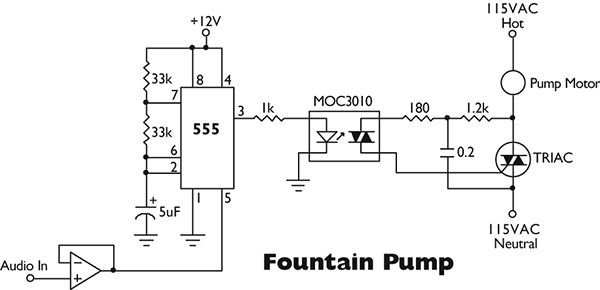With TJ Byers
Three Coins in a Fountain
Question:
I want to hook up one or more submersible fountain pumps (typically 115 VAC, 0.8 A) to a circuit that will vary the flow of water in concert with the input from a sound source. Should the circuit change the voltage or current?
Bob Slusher
via Internet
Answer:
Controlling the speed of an AC motor is fairly simple. It’s done all the time in hand drills, but what you’re trying to control is a flow of water, which has a lot of latency — resistance to change in flow. No matter how hard you try, the fountainhead won’t follow the fast-moving audio. The controller needs a low frequency filter to turn sporadic into rhythmic. Here’s what I’d do:

In this circuit, I’ve used the control voltage input (pin 5) of a 555 timer to PWM (pulse width modulate) the speed of the motor. With this design, the motor is never completely off — for good reason. Starting a water flow from a stall takes a lot longer than revving it up from a trickle, making your fountain slightly more responsive. It also takes care of the low frequency filter I mentioned earlier by using the inertia of the motor itself.
You have to provide the audio interface. Just make sure that the voltage sweep on pin 5 is between the Vcc and GND limits or you’ll fry the 555 chip.
This input is not linear over this range, which is okay for the type of output you desire. Also, 5 mF may not be ideal for your particular pumps. Play with it until it works right for your display.


Comments